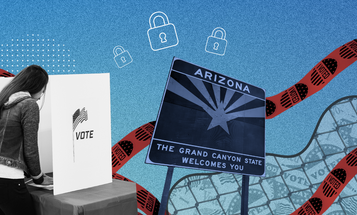
Peer Power: Facebook, Voting, and Social Influence
A new study from the University of California, San Diego, shows how a Facebook get-out-the-vote campaign can have a tangible impact on voter turnout—but only when there’s a certain sort of social component to it.
The researchers conducted an experiment on every American Facebook user who was 18 or older during the 2010 congressional elections—more than 61 million people. Most people in the group saw a message at the top of their News Feed that
encouraged the user to vote, provided a link to find local polling places, showed a clickable button reading ‘I voted’, showed a counter indicating how many other Facebook users had previously reported voting, and displayed up to six small randomly selected ‘profile pictures’ of the user’s Facebook friends who had already clicked the I Voted button.
Another group (which the researchers call the ‘information-only group’ in the paper) saw a similar message, but without pictures of their friends, and a final, control group didn’t see any message at all.
The results?
The users in the social group were about 2% more likely to have clicked the “I Voted” button than were users in the information-only group, and 0.39% more likely to have actually voted (the researchers, knowing that self-reporting was not a sufficient measure here, tracked down public voting records and matched them to the names of Facebook users to determine who had actually voted). Interestingly, the voting gap between the social group and the control group was also 0.39%, suggesting that the information-only campaign had no effect on actual voting behavior.
The researchers also found that the closer a given user was to a Facebook friend who reported having voted (as measured by their Facebook interactions), the more likely it was the voting effect would be contagious. In other words, my own behavior is more likely to change if I see that one of my best friends has voted than if I see that a Facebook friend who I met once at a party has voted.
One of the authors of the paper, James H. Fowler, a Professor of Medical Genetics and Political Science at UCSD, explained to me that his team’s result was part of a broader trend in the study of voting.
“There’s been a shift in political science away from thinking that voting is a rational cost-benefit decision to one that’s really a social decision,” he said. “We vote because our friends are. And I think that this study really supports that growing research.”
One obvious way this effect was highlighted in the study was the fact that, among the folks who received the socially oriented message, there was a much greater increase in the percentage of subjects who reported having voted via Facebook than the there was an increase in people who actually voted. So in situations where our behavior is public, we’re very concerned with acting in a way that conforms to local group norms—or at least giving the impression that we are. This is a powerful potential leverage point for policy makers designing interventions, whether we’re talking about voting, bullying, smoking, or any behavior with a public component.
Now, there are a couple notes of caution here. One is that the effect wasn’t all that large (though Fowler argued that over a large population, the numbers could easily add up, which is true). The other is that, when it comes to voting, the underlying demographic story should cause us to be much more concerned about turnout among underrepresented and disenfranchised groups than those who already have a seat at the table. But because of the way social networks work, it’s very easy for a given “treatment” to only spread among a population that doesn’t need the treatment in question.
That is, I vote and most of my friends vote, so you’re not going to get much mileage out of seeding my social network with a pro-voting intervention. It might be tougher to reach the people who need and would benefit most from the intervention.
On the other hand, this will be less of an issue as researchers get better and better at microtargeting certain nodes in a network, and it does nothing to detract from the key takeaway: social influences may be a much more potent tool for increasing voter turnout than blunter informational campaigns.
As Fowler put it, when it comes to these sorts of interventions, “if you’re not doing something social, you may not be doing anything at all.”



